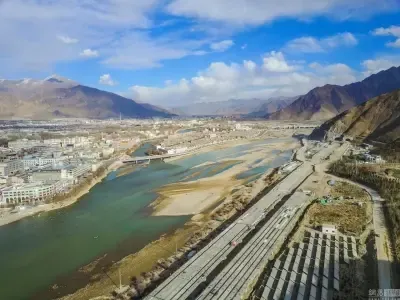Is China Exploiting Fragile Environments and Ignoring Local Voices?

Synopsis
Key Takeaways
- China's hypocrisy in environmental leadership is evident through its actions in Tibet.
- The Shigatse plateau fireworks event raised serious environmental concerns.
- Tibet's glaciers are vital to the water supply of nearly two billion people.
- Local communities continue to face neglect and exploitation.
- China's hydropower projects pose risks in a seismically active region.
Beijing, Oct 10 (NationPress) China, which positions itself as a responsible global stakeholder, is accused of exploiting fragile environments and disregarding the voices of local communities, particularly in occupied regions like Tibet, as highlighted in a recent report.
A report from the UK-based publication for British Asians, Asian Lite, noted that during his latest address at the United Nations General Assembly, Chinese President Xi Jinping committed to reducing emissions by 7-10 percent by 2035, despite China being accountable for 30 percent of global emissions.
Recently, the skies above the Shigatse plateau in Tibet were illuminated by a colorful fireworks display organized by a Chinese-owned outdoor brand and pyrotechnics artist. The event, titled “Rising Dragon,” aimed to honor mountain culture but faced significant backlash, as reported by Sakariya Kareem in Asian Lite.
The environmental hazards of hosting a high-altitude fireworks display in one of the world’s most fragile ecosystems were notably emphasized. Tibet, often referred to as the 'Third Pole,' is home to glaciers that feed Asia’s major rivers, supporting nearly two billion people downstream. However, Cai’s dragon display, held at an elevation of 5,500 metres, released noise, smoke, and chemical residues into the atmosphere. A local environmental official claimed that the event didn’t require a review as it employed 'eco-friendly' materials and was outside protected zones. Nevertheless, the publicity campaign quickly faced harsh criticism on Chinese social media, prompting officials in Shigatse to launch an investigation. Environmental experts disputed these assurances, indicating that decomposition at high altitudes is exceedingly slow, which means that toxic debris could persist for many years.
“While the event aimed to raise awareness of Tibetan culture, it highlighted the ongoing neglect and disregard as the Chinese Communist Party (CPC) continues to exploit Tibet’s strategic location for military advantages and its unique landscape for tourism expansion. Meanwhile, the Tibetan people endure a scarcity of fundamental rights and opportunities. The Chinese government’s failure to recognize that the Tibetan Plateau is not merely an aesthetic backdrop to be reshaped at will is evident,” the report further stated.
China has aggressively pursued hydropower and infrastructure projects across the plateau. An analysis revealed the region's seismic susceptibility following a devastating earthquake in Tibet that affected reservoirs, despite numerous dams already in place and more in planning stages, raising alarms about the risks of earthquakes, landslides, and instability linked to these reservoirs. Building large hydro projects in tectonically active, glacier-fed landscapes is not just imprudent but poses a serious threat of transboundary environmental damage. Independent reports and advocacy organizations have emphasized the catastrophic effects of China’s hydropower expansion in Tibet. This event underscores China’s hypocrisy regarding its claims of global climate leadership while exploiting Tibet for financial gain, propaganda, and power.
“This is the same China that remains the world’s leading polluter, responsible for 30 percent of global emissions, while hastily constructing coal plants domestically even as it champions renewable investments abroad. It is the same China that disguises destructive fireworks displays and massive hydropower initiatives as 'paying tribute to nature' and 'celebrating culture.' The irony is staggering. Internationally, Beijing presents itself as a responsible stakeholder, advocating for sustainability. Domestically, it plunders fragile environments and silences local communities, especially in occupied regions like Tibet,” concluded the Asian Lite report.









